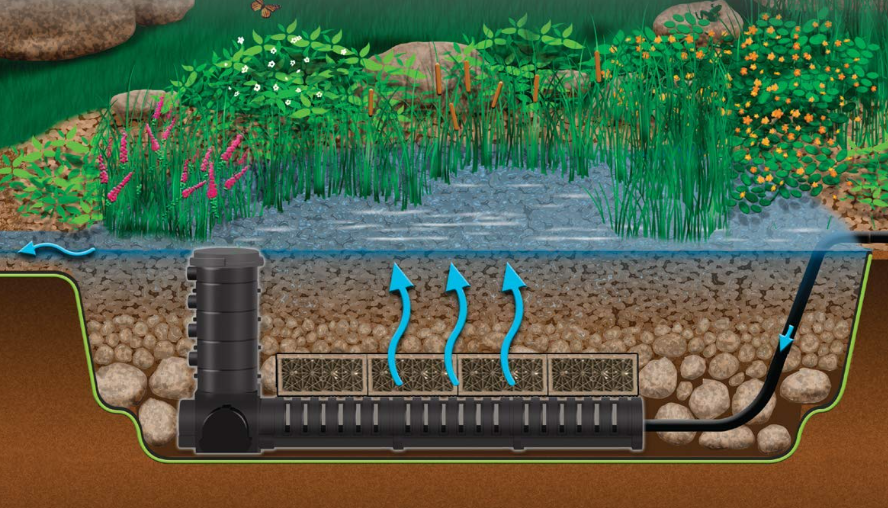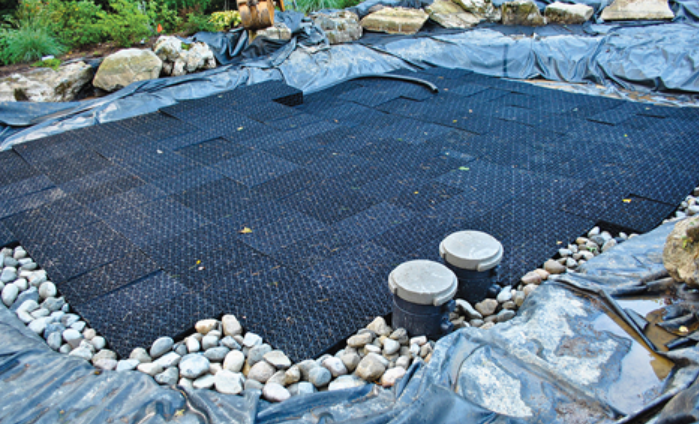Backyard koi ponds are intended to mimic nature, however they require mechanical and biological means to maintain a healthy ecosystem and clear water. A properly designed pond often includes a biological filter, which combines both mechanical and biological treatment, to maintain the health of a pond. Without a biological filter, a pond can quickly become overrun by algae and sediment.
Algae are naturally occurring microorganisms in water. Algae is necessary for a healthy biological system because aquatic life feeds on algae. However, when excess algae growth occurs, they consume large amounts of dissolved oxygen which depletes available oxygen for fish and other aquatic life. Additionally, excessive algae blocks light from penetrating the water surface, causing biological upset within the pond. Furthermore, odors often associated with stagnant water occur in an oxygen deficient environment. Excessive algae growth not only negatively impacts the pond’s ecosystem, but is also not visually appealing and creates an odorous environment.
Excess algae growth is caused when large quantities of nutrients (namely excess phosphorus and nitrogen) enter a water body. Nitrogen and phosphorus are necessary for a healthy pond, but “too much of a good thing, is not a good thing after all”. Excess nutrients is what can be considered a “Thanksgiving feast” for algae. Algae rapidly feed on the nitrogen and phosphorus, and begin multiplying uncontrollably. For a residential application, excess nutrients often enter the pond as fertilizer, waste from pets, and other nitrogen and phosphorus rich material.
This is where treatment is essential. When paired with a mechanical filter such as a pond skimmer or intake bay, there is nothing more efficient at removing algae than a wetland filter.
The first step for pond filtration is a mechanical pre-filter, often a surface skimmer, that is used to remove solids and floating debris. A properly designed skimmer can remove up to 90% of debris including leaves, twigs, sticks, pollen, fish waste, etc. from the pond. The style and size of mechanical pre-filter is dictated by the size of the pond.

As water passes through the mechanical pre-filter, it is pumped to the bottom of a wetland filter for biological treatment and further filtration. Water is pumped into a sedimentation chamber that is designed to reduce the velocity of the water. As the water slowly travels through the sedimentation chamber, solids and other debris that passed through the pre-filter settle out. It is recommended the pond owner clean the sedimentation chamber on an annual basis to remove settled solids.

After the sedimentation chamber, water flows upwards through three layers of cobble and gravel. Each layer is 8” deep, and the gravel diameter gets smaller towards the top of the filter. The first (bottom) layer consists of 4” to 8” diameter cobble, the second layer is 2 to 4” diameter gravel, and the top layer is pea gravel. The diameter decreases as water travels upwards to remove varying sizes of remaining solids. Additionally, the layers of gravel create a perfect space for healthy, bacteria to attach and thrive. These bacteria consume nutrients and organic carbon as their food source, effectively removing pollutants from the water.

The last and most important component of the wetland filter is vegetation, which is located at the top. Marginal plants with deep root systems are planted in the gravel. Vegetation planted within a wetland filter system is a very effective way to remove remaining nutrients. These plants have access to a constant supply of overly enriched water that they can use to grow and perform even better. It is important to use a variety of these marginal plants as that will increase the amount of nutrients being removed from the water and create a more robust ecosystem.


